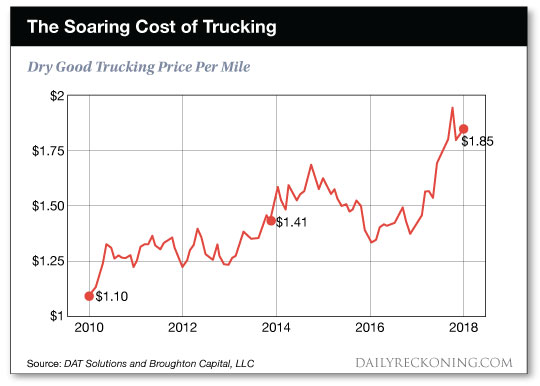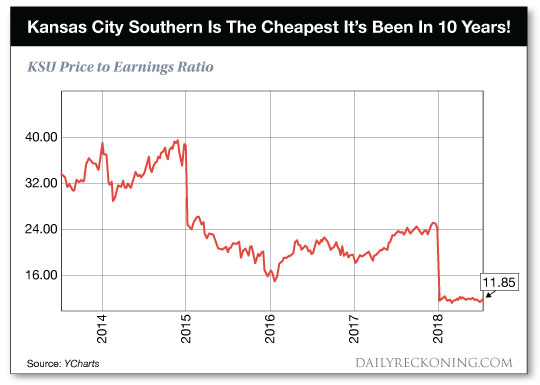&l;p&g;Action in the bond market exerts a huge influence on stocks and other asset classes, and as rates move higher, there will one day be a point at which even stock market investors flee risky assets for the guarantee of a juicy double-digit yield. We&a;rsquo;re not there yet, but going back more than a generation to the summer of 1981, the yield on the 10-year U.S. Treasury note topped 16%, and bank certificates of deposit would earn you an annual percentage yield of 17% or higher. Those days are long gone, but if interest rates adhere to their typical 36-year cycle of rising and falling, we may have turned the corner last year, and rates will be heading higher for the next several decades. Those fat yields from the 1980s may be reappearing in the early 2050s.
&l;img class=&q;size-full wp-image-6858&q; src=&q;http://blogs-images.forbes.com/johndobosz/files/2018/07/fred.jpg?width=960&q; alt=&q;&q; data-height=&q;469&q; data-width=&q;1163&q;&g; Source: Federal Reserve Bank of St. Louis.
My area of expertise is equity income investing, and I maintain a Top 25 portfolio of dividend-paying stocks that&s;s posted every Friday evening in &l;a href=&q;https://protect-us.mimecast.com/s/2EWDC31YDLf2MyXjcDNlnT&q; target=&q;_blank&q;&g;&l;em&g;Forbes Dividend Investor&l;/em&g;&l;/a&g;. The investment thesis here is that if you buy companies temporarily out of favor but still able to pay steady or even rising dividends, you lock into a situation with great capital gains potential, and a generous dividend yield, often 4% or higher.
I select stocks for the Top 25 using criteria that include discounts to five-year average multiples of price to sales, book value, earnings, cash flow and enterprise value/Ebitda (earnings before interest, taxes, depreciation and amortization). Stocks are rewarded for superior rates of dividend growth and revenue growth, as well as for high yields and low payout ratios. Operating cash flow over the past 12 months needs to be positive and must be sufficient to cover the dividend.
I track weekly performance of the Forbes Dividend Investor Top 25 model portfolio against 20 dividend ETFs. The equally-weighted Top 25 has produced a 5.2% year-to-date return, higher than any of the ETFs, except for the WisdomTree SmallCap Dividend Fund (DES), up 6.3% YTD through July 9.
Bigger has not been better in dividend stocks so far in 2018, as small-capitalization stocks have trounced their larger-cap brethren in terms of performance, a gap that&a;rsquo;s widened since the market corrected in early February, and again over the past two months. Year-to-date, the Russell 2000 Small Cap Index (IWM) ETF has returned 11.7%, more than double the 5.0% return from the large-cap SPDR S&a;amp;P 500 Index (SPY).
Over the past five months since the market began to recover from the January-February correction, DES has jumped higher by more than 12%, and so has the iShares Cohen &a;amp; Steers REIT (ICF) ETF, a proxy for U.S.-listed real estate investment trusts.
&l;img class=&q;size-full wp-image-6859&q; src=&q;http://blogs-images.forbes.com/johndobosz/files/2018/07/etfs.jpg?width=960&q; alt=&q;&q; data-height=&q;466&q; data-width=&q;700&q;&g; from Stockcharts
The outperformance of small-caps is due at least in part to fears of a trade war, which have taken a toll on large multinational companies that are heavily dependent on exports. Smaller companies, by comparison, tend to do nearly all their business domestically.
Raging performance of REITs since early February is a result of deeply oversold levels for many REITs earlier this year as interest rates jumped higher. Except for a spike in May, long-term interest rates have declined over the past five months. Meanwhile, REITs have favorable fundamentals with a strong economy, low unemployment and surging retail sales.
It makes sense that the Top 25 has enjoyed outperformance versus most dividend ETFs, because small-caps and REITs enjoy strong representation. Eight of the 25 stocks (32%) are REITs, and the median market capitalization of the stocks in the portfolio is $4 billion. Sixteen (64%) have a market capitalization less than $7 billion.
Here are two small-caps, one of them a REIT, currently on the Top 25.
West Palm Beach, Florida-based &l;strong&g;Chatham Lodging Trust&l;/strong&g; (CLDT) is a real estate investment trust that owns interests in 135 upscale and premium-branded hotels, with 18,516 rooms. Revenue this year is expected to climb 5% to $314.8 million, and funds from operations have grown 16.9% per year over the past five years.
Chatham is a monthly dividend-payer, with the ex-dividend date for the next $0.11 per share payout coming up on July 30. In addition to the monthly dividend and discounted valuations relative to history, what&a;rsquo;s also encouraging about Chatham is a &l;u&g;&l;a href=&q;https://protect-us.mimecast.com/s/DTUYC1wVAJFqmP6riGk26n&q; target=&q;_blank&q;&g;rash of insider buying going back to February&l;/a&g;&l;/u&g; by top company brass, including the chief executive officer, chief operating officer and chief investment officer. With a market capitalization of $990 million, Chatham is both a REIT and a small-cap.
Another small-cap recently added to the Top 25 is &l;strong&g;Pitney Bowes&l;/strong&g; (PBI). Founded in 1920 as a seller of postage metering equipment, the Stamford, Connecticut-based company has been forced to diversify and transform its business as electronic communications have supplanted many written notices sent through the U.S. Mail from businesses to customers. Today Pitney Bowes provides information management, location intelligence and customer engagement products and solutions, as well as shipping, mailing, fulfillment, returns and cross-border e-commerce products and solutions that enable the sending of parcels and packages. Revenue and Ebitda began to turn higher in the fourth quarter of last year, and the stock trades near a five-year low, with valuations severely discounted from five-year averages.
&l;u&g;&l;a href=&q;https://protect-us.mimecast.com/s/SqpCC2kGBKs8GBVLiBOMhz&q; target=&q;_blank&q;&g;Insiders have been buying company stock.&l;/a&g;&l;/u&g; The CEO purchased $100,000 worth of shares on May 8 at $9.02 per share, and the chief financial officer, somebody who should know what&a;rsquo;s going on with the numbers, purchased $88,000 worth at $8.82 per share.
Pitney Bowes is a bit of a scoundrel, having cut its dividend in half five years ago, so it warrants extraordinary suspicion, but with top officers buying stock and the revenue picture getting brighter, buying at five-year lows might look smart in several months&a;rsquo; time.
&l;em&g;John Dobosz is the editor of &l;a href=&q;https://protect-us.mimecast.com/s/2EWDC31YDLf2MyXjcDNlnT&q; target=&q;_blank&q;&g;Forbes Dividend Investor &l;/a&g;and &l;a href=&q;https://protect-us.mimecast.com/s/6rRhC4xW0MflWDzZtV0WNQ&q; target=&q;_blank&q;&g;Forbes Premium Income Report&l;/a&g;.&l;/em&g;&l;/p&g;
 1World (CURRENCY:1WO) traded 6.7% higher against the U.S. dollar during the 1 day period ending at 22:00 PM E.T. on July 21st. One 1World token can now be purchased for approximately $0.17 or 0.00002329 BTC on major exchanges. During the last week, 1World has traded 5.7% higher against the U.S. dollar. 1World has a market capitalization of $3.60 million and approximately $71,973.00 worth of 1World was traded on exchanges in the last day.
1World (CURRENCY:1WO) traded 6.7% higher against the U.S. dollar during the 1 day period ending at 22:00 PM E.T. on July 21st. One 1World token can now be purchased for approximately $0.17 or 0.00002329 BTC on major exchanges. During the last week, 1World has traded 5.7% higher against the U.S. dollar. 1World has a market capitalization of $3.60 million and approximately $71,973.00 worth of 1World was traded on exchanges in the last day. 



 Changes afoot for HBO under AT&T��s new reign
Changes afoot for HBO under AT&T��s new reign


 Millennium Management LLC increased its position in Sothebys (NYSE:BID) by 44.1% in the 1st quarter, according to the company in its most recent Form 13F filing with the Securities & Exchange Commission. The firm owned 308,524 shares of the specialty retailer’s stock after buying an additional 94,406 shares during the quarter. Millennium Management LLC owned about 0.60% of Sothebys worth $15,830,000 at the end of the most recent reporting period.
Millennium Management LLC increased its position in Sothebys (NYSE:BID) by 44.1% in the 1st quarter, according to the company in its most recent Form 13F filing with the Securities & Exchange Commission. The firm owned 308,524 shares of the specialty retailer’s stock after buying an additional 94,406 shares during the quarter. Millennium Management LLC owned about 0.60% of Sothebys worth $15,830,000 at the end of the most recent reporting period.